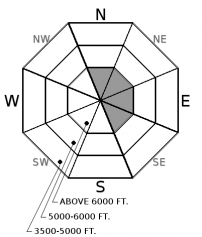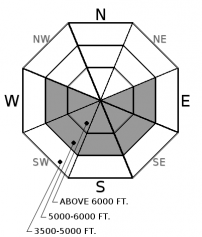| Sunday | Sunday Night | Monday | |
|---|---|---|---|
| Cloud Cover: | Dry conditions with light winds. | Light precipitation with cool temperatures. | Continued light precipitation with increasing winds. |
| Temperatures: | 31-47 deg. F. | 19-29 deg. F. | 31-47 deg. F. |
| Wind Direction: | Southwest | South-southwest | Southwest |
| Wind Speed: | 5-7 mph | 4-6 mph | 10-13 mph with gusts to 31 |
| Snowfall: | 0 in. | 0-1 in. | 0-2 in. |
| Snow Line: |
Whitefish Range
Swan Range
Flathead Range and Glacier National Park
How to read the forecast
Moderate to strong winds over the past 36 hours formed fresh wind slabs at upper elevations. In locations these slabs were deposited onto a crust and all wind loaded terrain should be evaluated before committing to a slope. Periods of sun today will weaken the snow surface on sunny aspects creating a loose wet avalanche problem. The avalanche danger is MODERATE above 6000' on wind loaded terrain and the danger will rise to MODERATE on sunny aspects above 5000'.

2. Moderate
?
Above 6500 ft.
2. Moderate
?
5000-6500 ft.
1. Low
?
3500-5000 ft.
- 1. Low
- 2. Moderate
- 3. Considerable
- 4. High
- 5. Extreme
-
Type ?
-
Aspect/Elevation ?

-
Likelihood ?CertainVery LikelyLikelyPossible
 Unlikely
Unlikely -
Size ?HistoricVery LargeLargeSmall

Friday night through early this morning saw moderate to strong sustained winds, with occasional extreme gusts, which drifted the light snow that fell at upper elevations Friday night. Reports from the Flathead Range, southern Glacier Park and the southern Whitefish Range note wind slab depths around 1 foot thick with varying hardness up to 1F hard. In some locations these fresh slabs have been deposited onto a melt freeze crust which will make for a slippery bed surface. Observations from Saturday varied from slabs that were stubborn to move to those that were easily affected by ski cutting. In one instance one intentionally triggered slide ran full path (~2000'). It seems as though it has been weeks since we last dealt with wind slabs so remember to evaluate all wind loaded terrain before committing to a slope today. These slabs are fresh and should be easy to identify by cracking in the snow beneath your skis or machine.
-
Type ?
-
Aspect/Elevation ?

-
Likelihood ?CertainVery LikelyLikelyPossible
 Unlikely
Unlikely -
Size ?HistoricVery LargeLargeSmall

Temperatures overnight dropped below freezing at all upper elevation weather stations across our advisory area which has helped to lock up the surface snow this morning. Today, we are expecting to see partly to mostly sunny skies and seasonal temperatures which will weaken the snow surface as the day progresses. The light snow that fell Friday night at upper elevations will be easily affected by today's warming and sun. If you find your skis or machine sinking through the surface into the unconsolidated snow beneath it is best to move to a different aspect or call it a day. Rollerballs (pinwheels) are often the first sign that the snow surface is becoming unstable.
Giant cornices exist along most ridgelines across the advisory area. It's important to pay attention to what is looming above you given the unusual size and how overhung many of these cornices are. Keep a good distance from these while traveling along ridge lines as they can pull out further back than expected, even behind the solid ground. When a large cornice falls it has the potential to trigger deep instabilities that would otherwise remain dormant resulting in a large avalanche.
Glide cracks have also been observed opening up in many locations. The first reported glide avalanche this season was March 25 and occured west of the WMR ski area in the southern Whitefish Range. There is a large amount of uncertainty associated with glide avalanches, so the best way to manage them is to avoid slopes where they are present.
Saturday: FAC staff traveled to Elk Mountain, in southern Glacier Park, where they noted active wind loading throughout the day with fresh wind slab development. Skiers in Marion Lake, in the Flathead Range, were able to intentionally trigger a wind slab avalanche that travelled 2000'. Skiers in the southern Whitefish Range observed small wind slabs that were reactive to skis and noted a glide avalanche failure.
Friday: FAC staff were in the Skyland area of the Flathead Range where a supportable surface crust existed throughout the day. Limited signs of avalanche activity were noted from the March 15 rain event. Skiers in the southern Whitefish Range noted glide cracks forming in several locations.
See below for all observations this season.
Yesterday was a "spring like" weather day with occasional squalls, periodic sun breaks, graupel, snow flurries, rain and breezy conditions. Skies cleared overnight and allowed temperatures to drop below freezing at all upper elevation weather stations throughout our advisory area. Currently, temperatures above 6000 feet range from 22-30ºF and winds are out of the southwest at 4-16 mph with gusts to 27. Today will be dry with light winds and partly sunny skies. Clouds and light precipitation will move back into our area tonight and last into tomorrow.
| 0600 temperature: | 22-30 deg. F. |
| Max. temperature in the last 24 hours: | 30-38 deg. F. |
| Average wind direction during the last 24 hours: | Southwest |
| Average wind speed during the last 24 hours: | 4-31 mph |
| Maximum wind gust in the last 24 hours: | 23-46 mph |
| New snowfall in the last 24 hours: | 0-2 inches |
| Total snow depth: | 87-122 inches |
This advisory applies only to backcountry areas outside established ski area boundaries. This advisory describes general avalanche conditions and local variations always occur. This advisory expires at midnight on the posted day unless otherwise noted. The information in this advisory is provided by the USDA Forest Service who is solely responsible for its content.



























